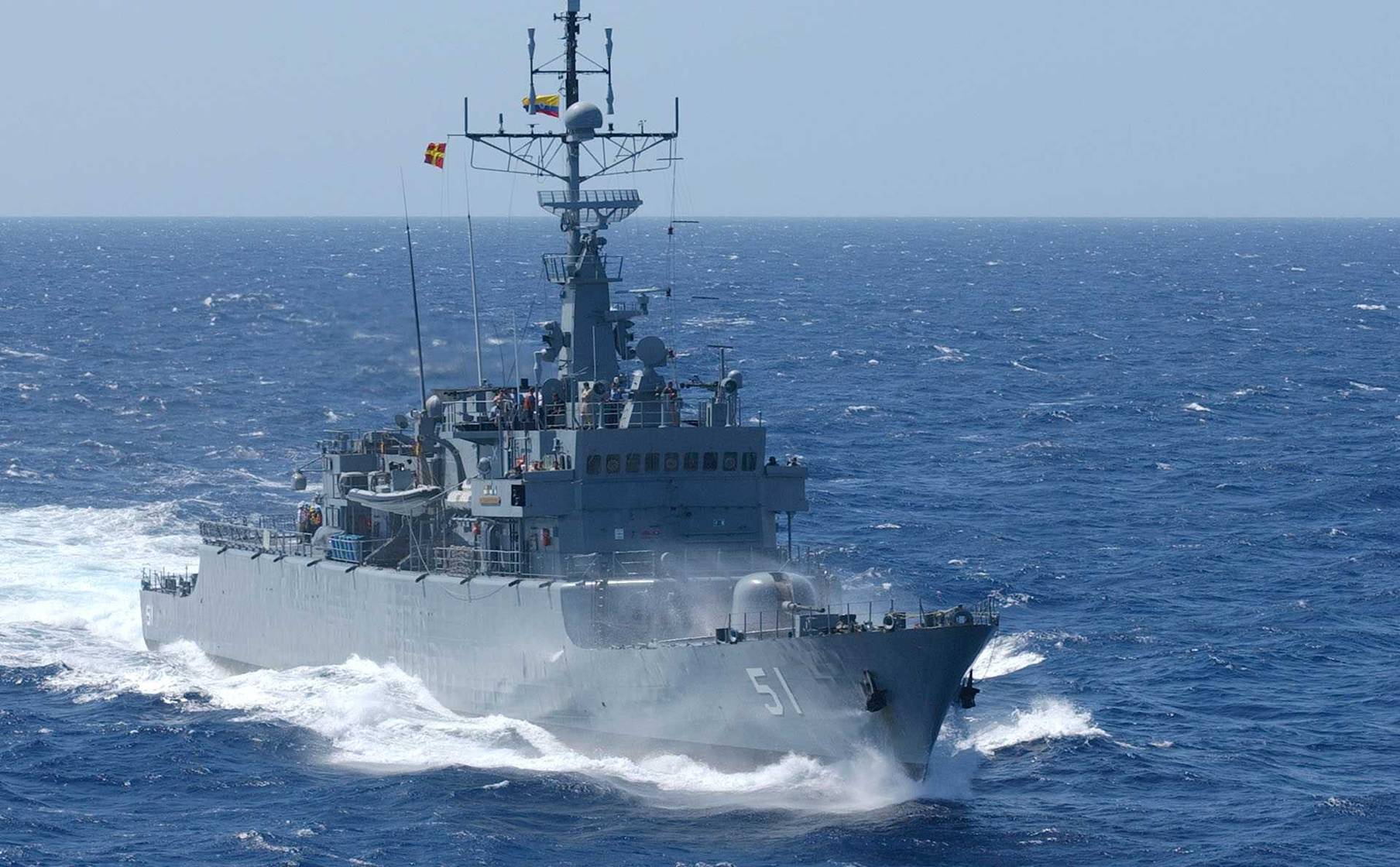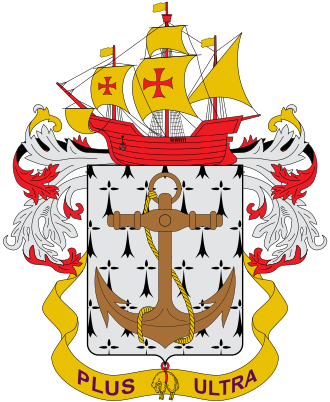ARC
coat of arms
The Colombian Navy, officially the Colombian National Navy (Spanish: Armada Nacional de la República de Colombia), also known as the "Armada Nacional" or just the "Armada" in Spanish, is the naval branch of the military forces of Colombia. The Navy is responsible for security and defence in the Colombian zones of both the Atlantic (Caribbean) and Pacific oceans, the extensive network of rivers inside the country, and a few small land areas under its direct jurisdiction.
The Colombian Navy has a strength of 35,086 personnel as of September 2013 including approximately 22,000 in the Marine Infantry corps.
The acronym "ARC", (Spanish: Armada de la República de Colombia) is used both as the official ship prefix for all the Colombian Navy ships, as well as a common short name for the Navy itself.
MISSION
The stated mission of the Colombian Navy is:
“Contribute with the defense of the Nation through the effective use of flexible naval power in the maritime, river and land spaces under its responsibility, in order to fulfill the constitutional role and participate in the development of sea power and the protection of the interests of Colombians".
In order to accomplish its mission, the Colombian navy establishes four strategic objectives:
1. Protection of the population and resources and consolidation of territorial control.
2. Neutralization of illegal drug trafficking.
3. Strategic deterrence.
4. Maritime and riverine safety.
In addition to functions of security and defense the Navy is called to participate in missions aimed to ensure the integral use of the sea by the Nation. For this purpose it must fulfill both military and diplomatic activities along with implementation and enforcement of law and order.
Its formal motto has been historically, "Plus Ultra" (Latin: further beyond); but more recently, and as part of a public media campaign in the 2000s, the additional slogan "Protecting the blue of our flag" (Spanish: Protegemos el azul de la bandera) became known and has been adopted institutionally as well, perhaps as a result of being a more relatable catchphrase to the public than the formal Latin motto.
Its former slogan was "Sailing our pride" (Spanish: Navega nuestro orgullo).
HISTORY
The history of the Colombian Navy is closely tied to, and somewhat reflects the history of Colombia itself: from its birth at the Declaration of Independence from Spain, the subsequent ups and downs throughout a later 19th century rife with civil wars, a 20th-century where it slowly starts asserting itself only to be challenged by the internal conflict and drug traffic of the later decades, to a Navy that is now reaching a more mature and modern shape, much like the country it protects.
19TH CENTURY ORIGINS
The Colombian Navy celebrates its birthday on July 24, the anniversary of the Battle of Lake Maracaibo fought on July 24, 1823, which was the last large naval battle of the
Spanish American wars of independence and helped cement the South American independence. But the roots of the Navy can be traced 13 years back, to 1810, just a few weeks after the Colombian Declaration of Independence of July 20, 1810. The president of the Supreme Board of Cartagena, José María García de Toledo, created the Naval Command Office (Spanish: Comandancia General de Marina) by means of a decree dated September 17, 1810. The Navy was placed under the command of Captain Juan Nepomuceno Eslava, junior son of the (former) Spanish Viceroy Sebastián de Eslava. During this period, the young navy operated mostly with small schooners, either acquired directly or by providing letters of marque to friendly captains which then operated as part or on behalf of the navy. Some of these captains would obtain later renown during the independence war, like Luis Brión and Renato Beluche. This small navy was effective in limited operations intercepting
Spanish ships, but was not strong enough to attack port cities, as evidenced by the failed attacks to Santa Marta (1813) and Portobello (1814).
During 1815, a Spanish army headed by Pablo Morillo besieged Cartagena, as the first step of its "Pacifying Expedition" (Spanish: Expedición Pacificadora). The five-month siege was so harsh that earned the city its title of "Heroic" (Spanish: La Heróica). The small independent navy was impotent against the large fleet commanded by Morillo, but nevertheless managed some daring actions, in particular that of Luis Brión, who attempted to run the blockade with his corvette Dard with a load of guns and powder to the city before fleeing again to Haiti. In 1816, Simón Bolívar attempted his first campaign, the Cayos expedition, sailing from Haiti with seven schooners and corvettes: Bolivar, Mariño, Piar, Constitución, Brión, Fénix, and Conejo. But this expedition fizzled out due to infighting amongst its generals shortly after the liberation of Margarita Island.
It was only after the Liberation Campaign of 1819 that General Francisco de Paula Santander created the Naval School on June 28, 1822, and issued additional decrees for the provision of the navy. Admiral José Prudencio Padilla would go on reorganizing and building the fleet, to support Bolívar's plans for the campaign of Zulia and the complete liberation of the east. This fleet then engaged in the Battle of Lake Maracaibo, which crushed the Spanish naval aspirations in South America.
In 1824 the first – and only – eight cadet officers graduated from naval school. On March 3, 1826, the Ministry of the Navy was created, with Lino de Clemente as minister. By 1826, both from bought and captured vessels, the Colombian Navy had become a respectable force, commanding a relatively large number of ships, including a ship of the line, a frigate, six corvettes, five brigantines, 10 schooners, 13 gunboats, and many minor vessels.
But the fledgling government was strapped financially, and in a decree of December 7, 1826, Bolívar decommissioned the Naval school, abolished the Ministry of the Navy, and slashed the budget for all navy and marine affairs by more than half. The Navy would not recover from this blow for almost a hundred years. The incipient navy of 1825 saw its ships slowly sold, scrapped, or abandoned, and by the late 1830s there were no more than a handful of serviceable ships, mostly assigned to the Army.
Under President Tomás Cipriano de Mosquera, a sizeable naval force was acquired during 1866, with the steamers of war Colombia, Cuaspud and Bolívar being purchased in England, and the Rayo acquired from America. Rayo was the largest, carrying four 9 inch guns, two smaller 30-pounders, and six torpedo launches, and was incorporated into the Colombian fleet after accusations she was due to be delivered to Chile or Peru for the war against Spain. It was not to last, congress decreed the ships of the navy should be sold on June 6, 1867. The Rayo was subsequently blown onto a reef September 12, 1867 and Cuaspud was wrecked on her delivery voyage just eleven days later. The Colombia was sold in 1868, and the Bolívar, last of Mosquera's men-of-war, sold in 1872.
During the rest of the 19th century, there was no formal navy to speak of. Some vessels and naval units were assigned to the Army, and throughout the civil wars of the 1880s, some transport vessels were hurriedly bought, and similarly disposed of, but no formal navy appeared.
On January 11, 1895, an important step was made in re-establishing the formal Colombian Navy when the three gunboats of the coastguard and the Magdalena were transferred from the Ministry of the Treasury to the Ministry of War.

SHIPS
In keeping with its three major operational scenarios: blue-water operations, littoral/riverine operations and coast guard, the ARC maintains a mix of ships suited to each of those profiles. The scope of its operation has been historically oriented towards lightly armed coastal patrol, and as such, the majority of its vessels had been usually mid-size cutters. Traditionally, the ARC has had strong ties to the American and German navies and shipbuilders and much of its equipment traces its roots to them.
Similar to other navies in the Latin-American region, the Colombian Navy acquired many vessels in the postwar years of the 1950s and 1960s, usually as war surplus from the US Navy, and then went through a somewhat dormant period during the 1960s to 1980s, during which few major acquisitions were performed.
In more recent years, the Colombian Navy has seen two major periods of upgrading and modernization of its equipment:
The first period, as a result of the rise of the drug trade in the late 1970s and 1980s as well as, at the time, increased political tensions in the Caribbean due to territorial disputes with some of its neighbors -with Nicaragua over the San Andres archipelago and with Venezuela over the Los Monjes Archipelago- saw the need for a stronger Caribbean patrol force, and resulted in the acquisition of its biggest vessels to date, four missile corvettes (later upgraded to light frigates) in 1983 as well as some additional patrol craft.
The second period, as a consequence of the deepening in the internal Colombian conflict, started in the late 1990s and extended over to 2005–2006, provided strengthening of its riverine and littoral capabilities, involving research and development for new indigenous designs in collaboration with the state-owned Cotecmar shipyards that resulted in new types of vessels such as the state-of-the-art Riverine Support Patrol Boats (Spanish: Patrullera de Apoyo Fluvial, "PAF"), also called "riverine mothership" (Spanish: Nodriza Fluvial) like ARC Juan Ricardo Oyola Vera (NF-613) which have drawn the eye of other navies with similar requirements.
Currently, the ARC is working on additional medium and long-term programs, including the development and acquisition of a number of coastal patrol vessels (Fassmer CPV-40) in 2011–2012, two oceanic patrol vessels (Fassmer OPV-80) (2011–2013), and the research and development of an indigenous corvette or frigate-class vessel ("Plataforma Estratégica de Superficie"), planned towards 2018–2020.
7 October 2011, South Korea is to donate a recently retired Pohang-class corvette to Colombia as part of a drive to boost arms exports to the South American region. An-Yang (PCC-755) was decommissioned by the Republic of Korea Navy (RoKN) on 29 September, having been active for some 28 years since entering service in 1983.
In September 2022, the Colombian Navy signed a contract for the design & construction of 5 new
frigates as part of the PES programma with Cotecmar shipyard and Damen Shipyards based on the SIGMA10514 design for delivery from 2026 onwards.
.....

